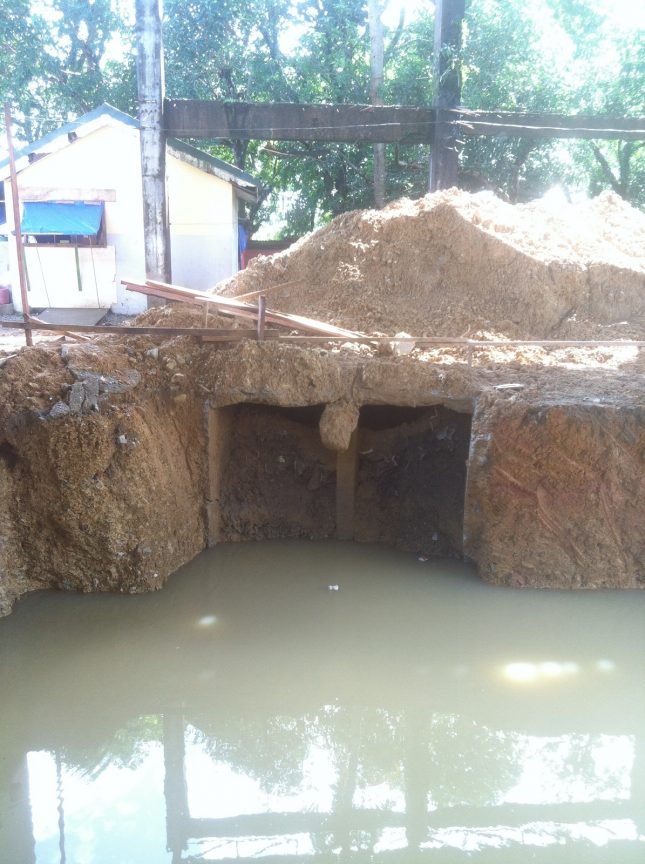SURIGAO CITY (MindaNews/24 January) — First they found a 500-pound American bomb. A few days after, construction workers discovered what could be a tunnel used by Japanese soldiers in the place where the Surigao del Norte National High School now stands.
The suspected Japanese tunnel lies around 20 meters from where the bomb was found, Alberto Geir, a foreman of construction company FFFJJJ told MindaNews on Sunday.
“It looks like a dugout or foxhole used by Japanese soldiers then,” he said.
Geir said that before they began the excavation work sometime in December last year, they were told about the presence of bombs and Japanese tunnel around the construction site.
“We found one big bomb and now this seems to be real,” he said, but clarified he is not an authority on the subject.
 A tunnel at the Surigao del Norte National High School in Surigao City which is believed to have been used by Japanese soldiers during World War II. Photo taken on January 22, 2017. Roel N. Catoto
A tunnel at the Surigao del Norte National High School in Surigao City which is believed to have been used by Japanese soldiers during World War II. Photo taken on January 22, 2017. Roel N. Catoto
The subcontractor of the project who requested anonymity said they will build four school buildings and an access road worth 93 million pesos.
“We will file for a suspension of work to the Department of Public Works and Highways because we are jeopardizing the students if there might be another bomb around,” he said, adding they will resume the excavation work by late March after the classes end.
Surigao del Norte National High School principal Aurelio J. Deguito said he believes the find is a Japanese tunnel.
“There are some stories I heard that this tunnel was created by some treasure hunters but I doubt it because it’s concrete,” he said on Monday afternoon.
He recalled that in the past few decades the school was a favorite spot for some treasure hunters.
Japanese soldiers used the school as their garrison during the Second World War.
Deguito said he will look for experts with equipment to inspect the school site for more vintage bombs, although Surigao City has requested the embassies of the United States and Japan to send teams to do the job.
Max Tandan Jr., a government employee in Surigao City recalled that as an elementary pupil in the 70’s, he entered one of the tunnels.
“I spotted inside the tunnel a helmet, water canteen, and there was a rising sun painted on the wall. I never looked for long because I was afraid then,” he said Tuesday.
On Jan. 15, Julito Calimpong, a backhoe operator, hit a metallic object while doing excavation work at the school. It was found at two meters deep, not six meters as earlier reported.
He thought it was some treasure that would make him rich.
He surreptitiously brought what he thought was treasure to the house of his employer, Danilo Orquina, former mayor of Bacuag in Surigao del Norte.
Orquina, who lives at Bernadette Village in this city, was quick to identify it as a vintage bomb and warned Calimpong and other workers not to touch it.
The bomb measured 54 inches long with a diameter of 14 inches. It had retained its original olive drab color.
Army bomb experts who came to Orquina’s house identified the bomb as an AN-M43 or M64 (Army Navy designation) 500 pounder containing HE/TNT/Almatol which is indicated by a visible 1-inch yellow stripe. It was used by naval aircraft like the SBD and SB2C dive bombers and the TBM/TBF torpedo bombers.
Explosive and Ordnance Division personnel of the Army’s 4th Infantry Division arrived at Bernadette Village on Tuesday morning and removed the bomb.
Some residents of the village were frightened upon being told to evacuate for their safety.
Johanne Jake Miranda, who once served in the Philippine Navy as a graduate of the Philippine Military Academy, said the EOD team confirmed that the bomb was live with its nose, tail booster fuses and body still in good condition.
Lt. Col. Colonel Rico Amaro, commanding officer of the 30th Infantry Battalion based in Bad-as, Placer in Surigao del Norte, said they have detonated the bomb last Saturday at the Manila Mining Company mine site.
Local historians said the bomb was among those that were dropped by US bombers during WWII.
“A bombing raid was conducted by such aircraft from carriers USS Essex and USS Lexington in Surigao City on September 9, 1944. This particular bomb was aimed at a Japanese Army garrison located on a hilltop, which is now Surigao High School,” said Miranda, who contributed significant work to the Battle of Surigao Strait Museum.
Dino Robert, a local historian based in Cantilan Surigao del Sur said air raid against Japanese forces in Surigao, which was a town then, took place in April 1945. (Roel N. Catoto/MindaNews)
